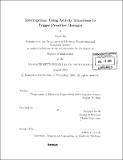| dc.contributor.advisor | Stephen Intille. | en_US |
| dc.contributor.author | Ho, Joyce (Joyce Carmen) | en_US |
| dc.contributor.other | Massachusetts Institute of Technology. Dept. of Electrical Engineering and Computer Science. | en_US |
| dc.date.accessioned | 2006-06-19T17:44:23Z | |
| dc.date.available | 2006-06-19T17:44:23Z | |
| dc.date.copyright | 2004 | en_US |
| dc.date.issued | 2004 | en_US |
| dc.identifier.uri | http://hdl.handle.net/1721.1/33135 | |
| dc.description | Thesis (M. Eng.)--Massachusetts Institute of Technology, Dept. of Electrical Engineering and Computer Science, 2004. | en_US |
| dc.description | Includes bibliographical references (p. 113-116). | en_US |
| dc.description.abstract | The proliferation of mobile devices and their tendency to present information proactively has led to an increase in device generated interruptions experienced by users. These interruptions are not confined to a particular physical space and are omnipresent. One possible strategy to lower the perceived burden of these interruptions is to cluster non-time-sensitive interruptions and deliver them during a physical activity transition. Since a user is already "interrupting" the current activity to engage in a new activity, the user will be more receptive to an interruption at this moment. This work compares the user's receptivity to an interruption triggered by an activity transition against a randomly generated interruption. A mobile computer system detects an activity transition with the use of wireless accelerometers. The results demonstrate that using this strategy reduces the perceived burden of the interruption. | en_US |
| dc.description.statementofresponsibility | by Joyce Ho. | en_US |
| dc.format.extent | 116 p. | en_US |
| dc.format.extent | 5482893 bytes | |
| dc.format.extent | 5490001 bytes | |
| dc.format.mimetype | application/pdf | |
| dc.format.mimetype | application/pdf | |
| dc.language.iso | eng | en_US |
| dc.publisher | Massachusetts Institute of Technology | en_US |
| dc.rights | M.I.T. theses are protected by copyright. They may be viewed from this source for any purpose, but reproduction or distribution in any format is prohibited without written permission. See provided URL for inquiries about permission. | en_US |
| dc.rights.uri | http://dspace.mit.edu/handle/1721.1/7582 | |
| dc.subject | Electrical Engineering and Computer Science. | en_US |
| dc.title | Interruptions : using activity transitions to trigger proactive messages | en_US |
| dc.title.alternative | Using activity transitions to trigger proactive messages | en_US |
| dc.type | Thesis | en_US |
| dc.description.degree | M.Eng. | en_US |
| dc.contributor.department | Massachusetts Institute of Technology. Department of Electrical Engineering and Computer Science | |
| dc.identifier.oclc | 62241850 | en_US |
